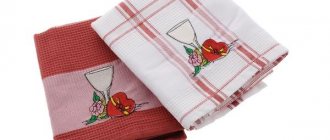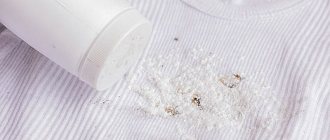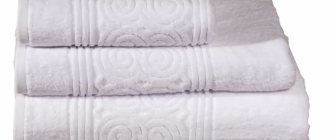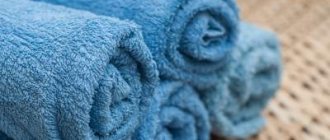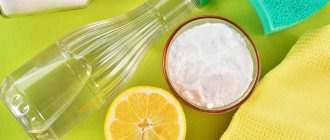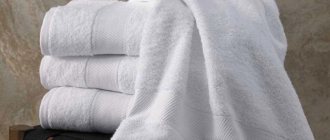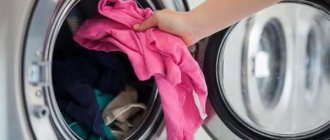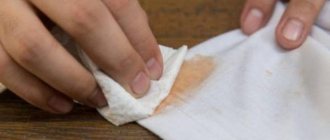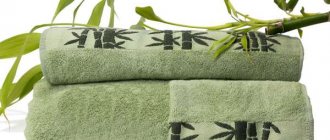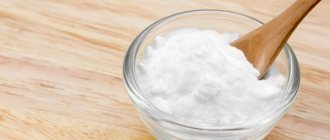/Order/
Basically, to wash kitchen towels, just throw them in the washing machine:
- White towels are washed at maximum time and temperature settings (90-100 degrees). If the towels are not too dirty, then the optimal temperature is 40-60 degrees.
- It is better to wash colored towels at a temperature of no more than 40 degrees.
However, to remove stubborn stains from, say, grease, coffee or beets, you need more serious measures and cunning tricks: boiling, soaking, using bleach and stain remover, soda, vinegar and other home remedies. We will talk about them in this article.
- The main thing is not to use radical methods more than once a month, so as not to wear out the fabric ahead of time. If you care for your kitchen towels properly, they will last for several years.
Another important note: Only white and light waffle towels can be boiled and bleached with chlorine bleach. Colored and terry napkins can be washed by hand/in the washing machine only with oxygen bleach and not for too long.
Method 2. How to wash kitchen towels in the microwave
How to wash and bleach kitchen towels without boiling? It’s very simple - create a boiling effect in the microwave. You will see that in just three minutes, most stains will disappear.
Instructions:
- Wet a kitchen towel in a bowl and rub it generously with laundry soap or any stain remover.
- Wring out the towel (not too much) and place it in a plastic bag without tying it.
- Place the tea towel bag in the microwave and run it on full power for 3 minutes.
If desired, the towels can be “boiled” in two or three batches for 3 minutes each.
- Wash towels as usual and rinse.
Stains remaining on kitchen towels can be removed locally with hydrogen peroxide (see Method 8 below).
Important rules for using towels in the kitchen
Kitchen towels are used daily in every home. In order for them to wash better, you need to comply with some conditions for their use.
- Keep at least three towels in the kitchen, changing them daily or when slightly soiled. This way you will be able to keep them clean much longer, the stains will not have time to set in too much, and washing will be easier.
- If the dirt is too strong, it is better to wipe it with disposable towels. This way you will not only save your nerves when figuring out how to wash the fabric, but also save a lot of money. Because it is not always possible to bring the material into proper form, and many housewives prefer to get rid of it right away.
- Avoid terry towels; they have increased properties of accumulating dirt. Waffles are ideal for the kitchen.
- Wipe the stove and sink with special cloths or sponges. Towels are not suitable for these purposes.
- Wash towels as often as possible, because stale fabric with greasy stains is much more difficult to clean.
- Such items should be washed separately from other laundry and at high temperatures.
- Do not be lazy to iron the towels on both sides after washing. This way you will keep them in their original pure form for longer.
Method 3. How to wash kitchen towels in a washing machine with bleach
This method is the first aid for dirty towels. Bleach removes grease and plant stains well, disinfects and eliminates unpleasant odors, and whitens yellowed or gray towels.
Important! Only oxygen-containing bleach is suitable for washing in the washing machine. Moreover, it is suitable for both white and colored linen. Even if your machine allows the use of bleach, you should not overuse it, as it is harmful to both the fabrics and the machine itself.
Instructions:
- Wet the towels with cold water and load them into the machine.
- Pour the required dose of bleach (most often it is 175 ml, that is, ¾ cup) into the powder receptacle compartment with the || icon, and if desired, add washing powder. It’s better to do this: first pour in the powder, let the machine pick it up, and then pour in/pour out the bleach.
- Select the desired temperature and wash time settings and start the machine. Wash light-colored towels for as long as possible at 90-100 degrees, and colored towels at 40-60 degrees.
Adviсe:
- Before pouring bleach into the cuvette, insert a special dispenser for liquid detergents into it (if your washing machine model has one).
- Do not use fabric softener as it is only good for clothes and bath towels. For kitchen textiles, conditioner is pointless - it does not eliminate, but only masks the unpleasant odor and, moreover, covers the material with a protective film, which reduces the efficiency of washing.
Soda stain remover
A homemade product copes with yellowness and stains of various origins.
- Water (1 cup) is brought to a boil in a small enamel saucepan.
- Add soda ash (1/4 cup) and mix thoroughly.
- Add 3% hydrogen peroxide (1/2 cup).
- Fill a two-liter bottle with a sprayer with 1.5 liters of warm water, pour the prepared mixture and shake well.
Before washing, you need to spray the solution on stains and yellowing, leave for 10 minutes (for stubborn stubborn stains - 1-2 hours), then wash.
Another option: mix 1 tbsp in a bag. l. soda, salt and washing powder. Place towels there. Tie the bag and squeeze the contents well. After an hour, wash as usual.
Lifehack. A paste of water and soda, applied to scorch marks, dried and brushed off with a stiff brush, helps lighten them or remove them without a trace.
Method 4. How to boil kitchen towels - basic instructions
Boiling can help if you don't have a washing machine at home or if your towels seem so dirty that it's easier to throw them away than try to wash them.
Important! Colored kitchen towels should not be boiled.
- Fill a large saucepan/basin/metal bucket about 2/3 full with water. Add washing powder/bleach/stain remover/other detergent to it at the rate of: 2 tablespoons of detergent per 1 liter of water (unless otherwise indicated in the product instructions).
- Place a bowl over medium heat, add towels and bring the solution to a boil. Try to stir the contents of the basin as often as possible.
- When the solution boils, reduce the heat to low and continue to cook the kitchen towels for 15 minutes to 2 hours, depending on the degree of soiling and the color of the fabric. It is better to boil colored towels for no more than 15-20 minutes; light-colored towels should be left longer. Do not forget to constantly stir the contents of the basin.
- Now that the towels have boiled, transfer them to an empty bowl using tongs and leave to cool.
- Wring out the cooled items thoroughly and rinse as usual.
Adviсe:
- Before boiling with bleach, it is advisable to first wash your towels by hand or in a washing machine.
Washing powder can be replaced with a mixture of laundry soap (72%) and soda. Grate the soap on a medium grater at the rate of 2 tablespoons per 1 liter of water, pour the shavings into the water, then add soda at the rate of 1 tbsp. spoon per 1 liter of water. Next, boil the kitchen towels in this solution, following the basic instructions above. You can also use baking soda and soap separately.
Vegetable oil
At first glance, it may seem that this is the craziest example of how you can try to clean a fabric product from dirt. Nevertheless, the technique has been tested for quite a long time and traditional methods often turn out to be the most practical and effective.
The oil should not be used in its pure form, or rather, for the magical cleansing solution you will need more than just it. Write it down. The following ingredients and sequential steps will be needed:
- a bucket or basin with a capacity of at least eight liters of water,
- directly 8 liters of water, which must be placed in the container described above,
- Next you need to grate 4 tablespoons of household soap,
- add 20 grams of classic baking soda to grated soap shavings,
- Pour about two tablespoons of vegetable oil into the mixture obtained at the previous stage,
- The next step is to mix the resulting substrate thoroughly in water.
Fabrics in need of treatment should be placed in the soapy liquid so that they are completely covered with the liquid. The ideal soaking time is about ten hours. There may be a longer wait due to significant contamination.
The disadvantage of this method is that mechanical treatment by hand washing or using a washing machine will most likely have to be scheduled no earlier than the next day.
A clear plus is that there is no need to boil the products; things will last longer faithfully.
Method 5. First aid against unpleasant odors - washing with vinegar
The simplest and most effective remedy for the stench of moldy towels is vinegar.
In the washing machine:
- Load dirty towels into the washing machine, add laundry detergent, and select the highest temperature and wash time settings.
- Pour 1/2 to 1 cup of 9% vinegar into the conditioner compartment before or during washing. During the rinse phase, the vinegar will enter the drum and remove odors.
- Remove and hang washed towels immediately after washing.
Manually:
- Soak the product for 5-10 minutes in a 5-9% vinegar solution (can be mixed with water in a 1:1 ratio).
- Rinse the towels thoroughly and hang them up immediately.
See also the material: How to clean the iron inside and outside - 10 home methods.
Useful tips
- For some kitchen operations, towel replacements are quite suitable. With this simple word we designate useful assistants for any housewife - these are various sponges, rags, and potholders. Use them at least occasionally and cotton textile fabrics will last you much longer.
- Don't forget to change towels often. This way, you will avoid the appearance of old stains, which are much more difficult to deal with. Agree, it is much easier to prevent a problem than to look for solutions.
- Use an iron. If dried, washed towels are ironed on both sides, this will promote additional disinfection (which is very important now).
Following these simple tips will significantly extend the life of your items. We hope that the information in the article was useful to you. If this is indeed the case, then we will be infinitely glad if you share a link to it by clicking on the appropriate social network button below and leaving a rating.
Method 6. How to whiten kitchen towels without bleach (3 home remedies)
- Using mustard powder. This method can both disinfect and bleach kitchen towels. To do this, dry mustard powder is diluted in hot water to a thick paste, after which the mixture is applied to wet towels, left for 6-8 hours and finally washed.
- Using potassium permanganate. This is a very effective method that works almost always. For a basin of boiling water you need about 200 g of washing powder and a little potassium permanganate (the water should be only slightly pink). Place pre-washed items in the solution, cover the basin with film and wait until the water has cooled completely. Finally, rinse the towels well.
- Using boric acid. This method is suitable for washing thick, waffle or terry towels. Add 2 tablespoons of boric acid to a bowl of hot water, then soak dirty towels in the resulting solution for 2 hours. Finally, wash them as usual and rinse them.
Types of towels and types of their stains
It is best to use towels for the kitchen made from short-haired materials with good absorbency: cotton, linen or bamboo. Nowadays fabric mixes are popular, for example, a mixture of linen and cotton. These towels are very durable and hygroscopic, almost do not fade and are wash-resistant.
In our kitchens you can often see the following towels:
- terry - soft, fluffy towels made of threads of different densities and colors;
- waffle - made from linen and cotton by special weaving of threads, creating a waffle-shaped pattern;
- stuffed towels;
- special paper kitchen towels.
The last option is disposable. This towel does not need to be washed; it is thrown into the trash bin after use. And we'll talk about the other types.
Choose kitchen towels made from soft, absorbent fabric
Terry towels are very soft, pleasant to the touch and wipe away water and dirt well. But on the other hand, it is precisely this property that makes such towels not the best choice for working in the kitchen: microbes accumulate and reliably colonize in terry fabric, and besides, it takes a long time to dry. Caring for such a towel will be tedious. Therefore, experts recommend cotton and linen, in particular, very comfortable waffle napkins.
Method 7. How to remove stains with citric acid
Citric acid can remove stains of various origins, but is especially effective at removing stains from beets and tomatoes.
Instructions:
- First, wash the towel with laundry soap under running hot water and wring it out a little.
- Sprinkle citric acid on the stains and leave for 5 minutes. If the stains are old, leave the towel on for an hour.
- Rinse as usual.
Necessity of boiling
Boiling laundry takes a long time, but for some people this procedure is necessary.
- In the case of increased skin sensitivity, the appearance of an allergic reaction to washing powders, gels, you have to boil the laundry in order to get rid of stains on clothes without harming yourself.
- Linen can be boiled for disinfection purposes. For children's clothing, boiling is the best option to remove difficult stains and carry out proper treatment.
As a rule, this process takes from half an hour to two. The time is determined by the degree of contamination of things and the type of fabric. After the recommended time has passed, you need to wait another half hour to an hour for the laundry to cool down. This will prevent the possibility of burns.
Question answer
- How to wash kitchen towels in a washing machine correctly? Firstly, temperature is important. As we have already noted, a temperature of 90-100 degrees is suitable for white products, and 40-60 degrees for colored products. Secondly, it is best to wash kitchen towels separately from clothes, linen, etc. Third tip: if necessary, it is better to pre-soak very dirty towels.
- How to achieve the best whitening results? First, the laundry needs to be washed or soaked with powder and only then proceed to bleaching.
- What's the best way to store dirty kitchen towels at home? This method is perhaps the most convenient: hang a basket or small bag (preferably mesh) on a hook somewhere in the kitchen. The towels will dry and be stored there until wash day. And if you allocate a place nearby for storing clean towels, then changing kitchen textiles will become even more convenient.
- How often should I wash and change towels? Ideally, once a day, especially if you are an active cook, have a large family and cook several times every day. Another tip: try to wash and change towels after drying your hands/cutting board/utensils when cooking raw meat, fish or eggs.
- Which towels are more practical? For wiping dishes, surfaces, vegetables and fruits, it is better to have waffle or smooth kitchen towels.
- But terry towels are appropriate in the kitchen only for drying hands, as dirt accumulates in them more quickly. To make your kitchen towels less dirty at first, try ironing them after washing.
- How many towels should there be in the kitchen? Typically, a duty set includes: a hand towel, a towel for wiping dishes and vegetables, and, if desired, a towel for wiping work surfaces, sinks, and cutting boards (in addition to a rag). In any case, you can’t have too many towels in the kitchen, because the more often we change them, the less we dirty them and wear them out with aggressive washing.
- How to prevent odor? Air dry your kitchen towels before putting them in the laundry hamper. After washing, try to immediately hang the items, ideally dry them in the sun or on a hot radiator. To ensure your textiles have a pleasant aroma, add a mixture of baking soda and your favorite essential oil to the water when rinsing kitchen towels.
Support the project - share the material with your friends on social networks:
Reviews from experienced housewives
Anastasia Deryabina, Orsk. I always thought that boiling was just some kind of anachronism, obscurantism in the kitchen. But my friend persuaded me, I tried it. This is amazing! Boiling with baking soda and ammonia made my towels as white as snow! I starched the lace and hung it in a prominent place in the kitchen; my husband wondered for a long time where I got the new ones from. So now I'm researching recipes.
Galina Ivanova, Nevinnomyssk. Kitchen towels bleach perfectly. I just don’t need it often, and I wear gloves. I soaked it in baking soda with soap or vinegar, let it sit, washed it - I’m happy! Neighbors walk around and wonder how I make such juicy and bright towels. I will recommend the recipe with butter to them. I don't mind, I like to surprise.
Oksana Klopova, Moscow. The stores are full of household chemicals. But it bites both in price and in composition. And so, I stocked up on baking soda (baking soda and ash), and everything in the house sparkles. Not a single spot without any advertised products. And it’s impossible to wash kitchen towels without baking soda.
How to whiten white socks at home.
